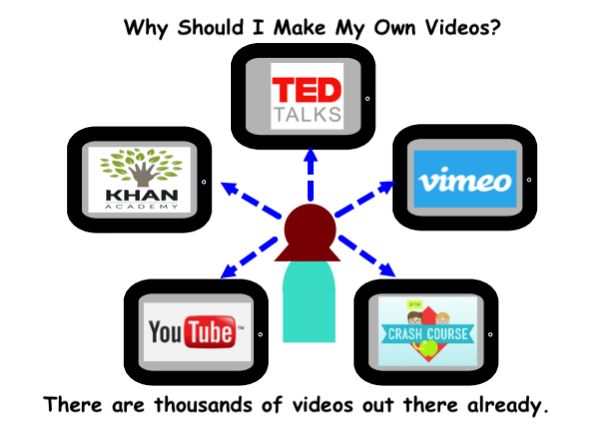“FLIPPED” Classroom Is All About The Relationships
Most educators who consider flipping develop angst beginning
with the fear of making videos. The concerns typically center on the time
necessary to make the videos, the technological skills to produce the videos or
the where with all to put voice and/or face on public display. And of course there is the option to use the
million or so videos that are already available through, YouTube, Vimeo,
Teacher Tube, etc… But I shout from the highest blog post, IT IS NOT ABOUT THE
VIDEO!!!
The success of any classroom but specially a “Flipped”
classroom is in the building of relationships.
There are three primary relationships that are central to the success of
the flipped classroom. These are, in no
particular order: Student to Subject, Student to Student and Student to
Teacher.
The Student to Subject Relationship.
Just because I now flip my class, I still get the
occasional, “When am I going to use this in real life?” response from a
student. However, this has diminished significantly as a result of focusing my
classroom on three key aspects, a more inquiry based hands on approach, more
peer teaching and learning and more exposure to the subject matter in the real
world. Each of these aspects have
immersed students in the material in a way that they see greater value in the
subject.
 Students who experience learning and are encouraged seek answers
to their own questions are very seldom bored with the subject. They find the content delivered outside of
class time as more valuable to their success in class.
Students who experience learning and are encouraged seek answers
to their own questions are very seldom bored with the subject. They find the content delivered outside of
class time as more valuable to their success in class.
Students who are responsible for their peer’s learning
success tend to develop an understanding that their own success is dependent
upon the success of those who surround them.
They become more responsible not only for themselves but also for their
peers. Their need to fit in becomes
dependent upon their preparation and therefore they value the subject more.
Providing resources outside of class to experience how the
subject works in the world brings light to the importance of the subject
content. Providing personal experience,
guest speakers in person or through virtual content, and projects that connect
the content and student to their world brings value to the subject.
The Student to Student Relationship
 In 1981 Dr. Gary Phillips conducted research for the
National School improvement Project.
While his results brought about some minor changes in educational
circles in the decade of the eighties, there is one piece of his data that
stands out. Three months after we have
learned some thing, we will remember 92% of what we have taught to someone
else. It is in the process of gathering
information, taking ownership of the knowledge and then taking responsibility
for sharing that material with someone else that we solidify our own
understanding of the subject. Students
who can develop a trust in themselves and their peers for the process of
learning will master material at a greater rate and consistency than those who
learn on their own.
In 1981 Dr. Gary Phillips conducted research for the
National School improvement Project.
While his results brought about some minor changes in educational
circles in the decade of the eighties, there is one piece of his data that
stands out. Three months after we have
learned some thing, we will remember 92% of what we have taught to someone
else. It is in the process of gathering
information, taking ownership of the knowledge and then taking responsibility
for sharing that material with someone else that we solidify our own
understanding of the subject. Students
who can develop a trust in themselves and their peers for the process of
learning will master material at a greater rate and consistency than those who
learn on their own.
While the “Flipped” model provides opportunity for
individualized instruction and the possibility for a mastery level approach. However, the true value of the flipped model comes from the opportunities for greater
student interaction and more peer to peer teaching . It is in building those students
relationships that students develop accountability for themselves and to their
peers.
The Student to Teacher Relationship
The “Flipped” classroom is best structured as a student
centered learning environment. This means that the educator must transition
from the deliverer of content to the facilitator of learning; the “Sage on the
Stage” becomes the “Guide on the Side”.
It is in this role that the flipped educator can interact with students
in a way that provides opportunities for assessment, remediation, and
inspiration.
 The flipped educator creates the path for learning and
allows the student the opportunity to take ownership of their mastery of the
subject. As the facilitator of learning
the educator acts as guide and mentor taking advantage of teachable moments and
learning opportunities that will enhance the student experience in the subject.
The flipped educator creates the path for learning and
allows the student the opportunity to take ownership of their mastery of the
subject. As the facilitator of learning
the educator acts as guide and mentor taking advantage of teachable moments and
learning opportunities that will enhance the student experience in the subject.
When students return for their 20 year reunion, the
discussion will never begin with, “Oh man, I remember that great packet of 10
problems you gave us for gas laws.” The conversation will always be about the
relationships tended. How they felt, and what they experienced.
While the videos may play a pivotal role in providing
delivery of content outside of the classroom, it is the time created in the
classroom that becomes invaluable to developing the relationships that allow
students to take ownership of their learning path and provide value to the
subject matter.




